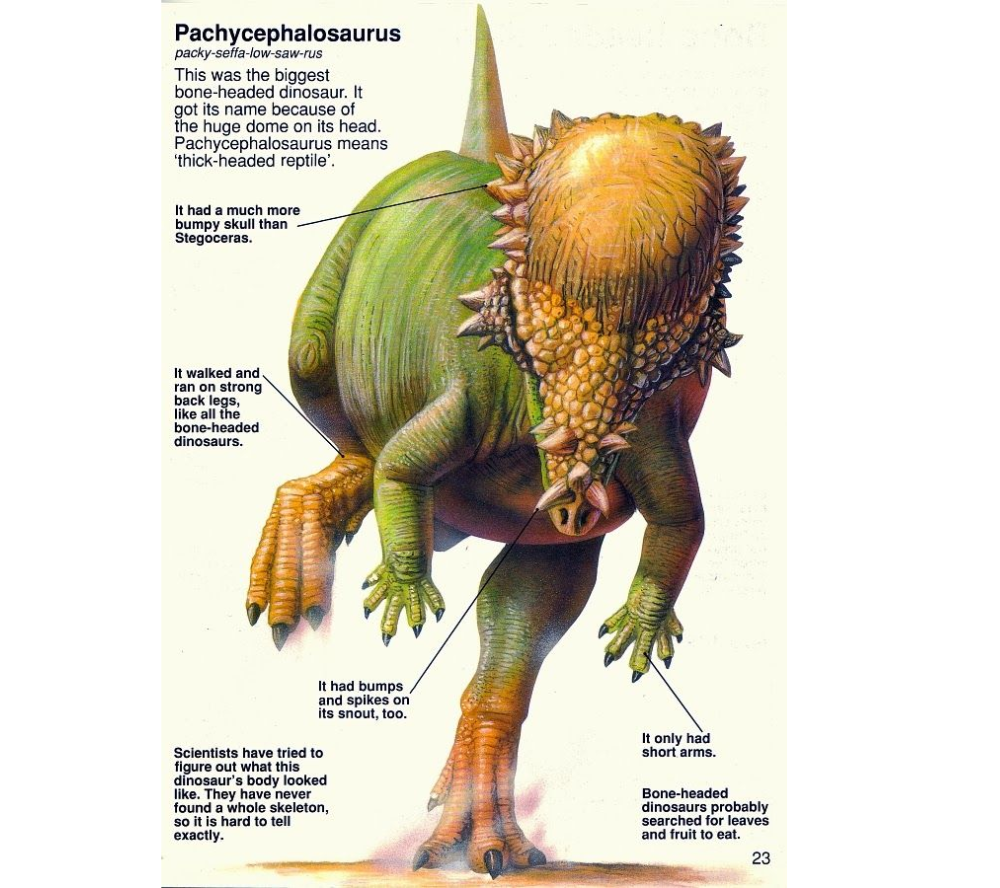Title & Overview
The image features Pachycephalosaurus, the largest known pachycephalosaurid dinosaur, renowned for its thick, domed skull. The content blends paleontological facts with reconstructions based on fossil evidence.

Key Sections & Content
1. Basic Information
-
Name Meaning: “Thick-headed reptile” (Pachycephalosaurus).
-
Pronunciation Guide: “packy-selfa-low-saw-rus” (phonetic aid).
-
Era: Late Cretaceous (~70 million years ago).
-
Diet: Likely herbivorous (leaves, fruits, seeds).
2. Distinctive Features
-
Skull Dome: Up to 25 cm (10 inches) thick—possibly used for:
-
Head-butting (intraspecies combat).
-
Display (species recognition/mating).
-
-
Bumps & Spikes: Smaller protrusions on the snout and back of the skull.
-
Body Structure:
-
Bipedal: Walked on strong hind legs.
-
Short Arms: Typical of pachycephalosaurs.
-
3. Fossil Challenges
-
Incomplete Skeletons: No full skeleton found—body reconstructions rely on related species (e.g., Stegoceras).
-
Size Estimates: ~4.5 meters (15 ft) long, weighing ~450 kg (1,000 lbs).
4. Behavior & Ecology
-
Social Behavior: Potential head-butting contests (debated—some argue domes were for flank-shoving).
-
Habitat: Lush Late Cretaceous forests (North America).
Visual Inference
The image likely includes:
-
A side-profile illustration of Pachycephalosaurus, emphasizing:
-
The dome-shaped skull.
-
Bony snout bumps and short forelimbs.
-
-
Size comparison (e.g., human silhouette for scale).
-
Hypothetical herd scene (suggesting social behavior).
Errors & Improvements
-
Missing Data:
-
Add time period (Late Cretaceous).
-
Clarify geographic range (e.g., Montana, USA).
-
-
Design Enhancements:
-
Labeled diagram: Highlight skull anatomy (dome, spikes).
-
Head-butting illustration: Show hypothesized combat.
-
Timeline: Place it among other Late Cretaceous dinosaurs (e.g., T. rex).
-
-
Text Refinements:
-
Replace vague phrases like “probably searched for leaves” with:
-
“Likely a browser, eating low-growing plants and fruits.”
-
-
Scientific Debates
-
Head-Butting Controversy:
-
Some scientists argue the dome could not withstand direct impact.
-
Alternative theory: Side-shoving displays (like modern bighorn sheep).
-
Final Assessment
Strengths: Clear focus on unique skull adaptations; accessible language.
Weaknesses: Lacks temporal/geographic context; oversimplifies behavior.
Rating: 8/10 (Strong foundation—needs minor additions).
Did You Know?
Pachycephalosaurus’ dome was so thick, paleontologists initially mistook fossils for knee caps!
Ideal For: Dinosaur exhibits, school projects, or科普读物.
Want More? I can add:
-
A comparison table with Stegoceras.
-
A predator-prey dynamic (e.g., avoiding T. rex).
-
A redesigned layout with visuals. Let me know!
